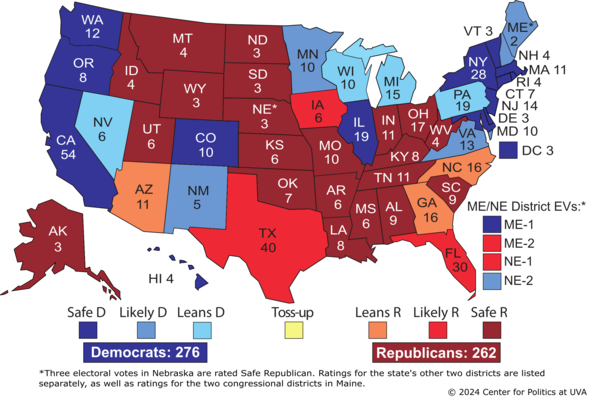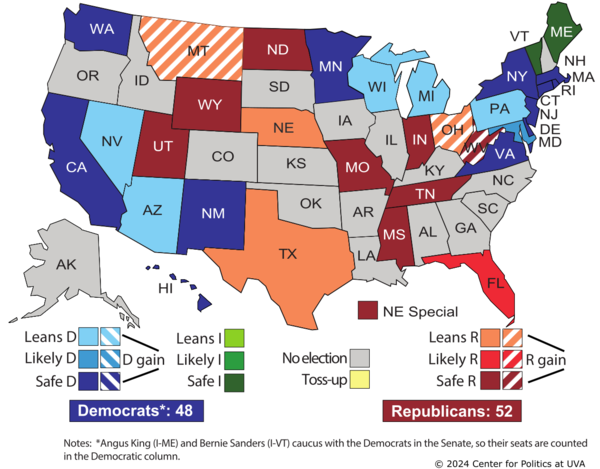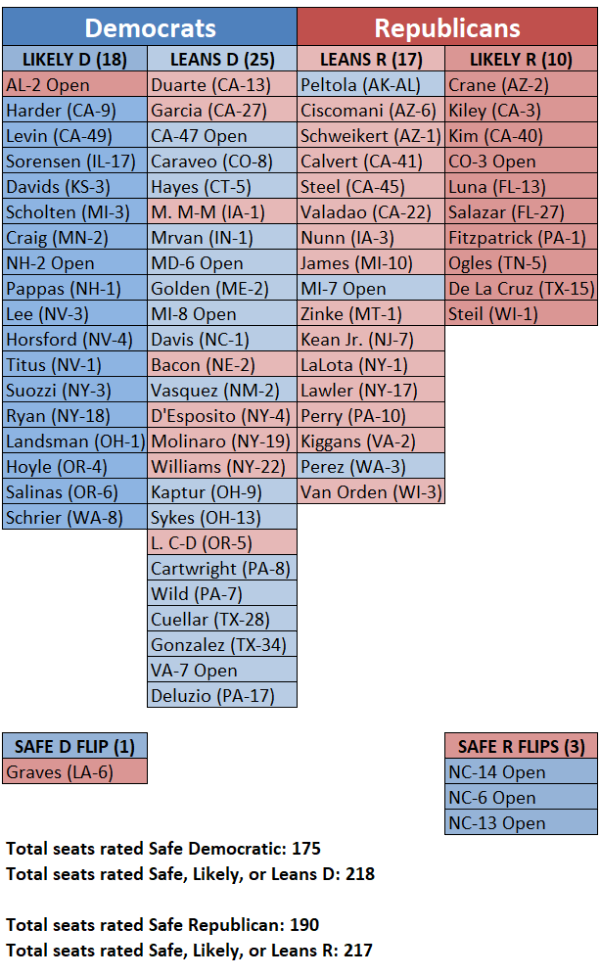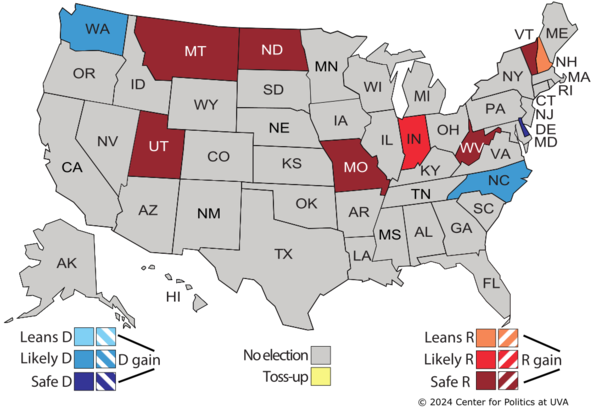Our Final 2024 Ratings
A Commentary By Larry J. Sabato, Kyle Kondik, and J. Miles Coleman
We mentioned a few weeks ago that we misplaced our Crystal Ball. As an update, we regret to say that we still have not found it. So no final ratings this year. Have fun on Tuesday!
…
…
…
OK, fine, we’ll give it a try.
We are not going to try to concoct some grand theory as to why one candidate may be favored in this election. We’ve tried them all out, and we don’t find anything that is convincing—if we did, we would have said so by now. We will leave it to the Wednesday morning quarterbacks—or is it Thursday or Friday?—to tell us how clear it was that Kamala Harris or Donald Trump would win. These things seem obvious in hindsight, but the outcome sure doesn’t seem obvious to us now.
The polls, collectively, aren’t really providing a clear signal—and, even if they were, we’d likely be suspicious of that signal, given polling challenges in the last two presidential elections.
Let’s just get to the 7 key states. What follows is based on off-record conversations with contacts, our sense of the polling picture, past history, and more.
We’ll start with the hardest swing state of all: Iowa.
(Just kidding—we think—but we’ll get to the nuclear blast that was J. Ann Selzer’s latest poll shortly.)
The polling, and our intel, converge on the idea that Arizona has emerged as Trump’s top opportunity for a win among the 7 key swing states.
What has surprised us down the stretch, meanwhile, is that Georgia and North Carolina are both gettable for Kamala Harris. A week or two ago, we were taking it almost for granted that while these states would of course be close, they would break toward Trump at the end. This is now far from guaranteed. Trump himself was campaigning in North Carolina on Saturday, Sunday, and today. While we have heard some arguments as to why this isn’t that big of a deal, we do take this as something of a signal about that state, particularly when combined with our own intel and the stubbornly close polls. Nevada, also apparently super-close, saw Republicans get out to a lead in the advance vote, leaving it an open question as to whether Democrats could catch up.
Of the Industrial North battlegrounds, our strong prior has been that Michigan was likely to be the bluest of these states. We are sticking with that prior belief despite obvious signs that Harris has not nailed it down.
Pennsylvania may be the biggest wild card, and the most responsive to whatever has (or has not) changed in the final days of the campaign, because it ultimately does not have that much advance vote. Something like 70% or even more of the total Pennsylvania vote will be cast on Election Day, clearly the highest of the 7 key battlegrounds, according to calculations we made from turnout expert Michael McDonald’s overall turnout forecasts and reporting of votes cast so far.
Our prior belief heading into the election season was that Wisconsin would be the hardest Industrial North state for Democrats to hold, both because it was the closest state Joe Biden carried in the region and because it skews whiter and more rural than the other two. Yet this does not seem to be the elite consensus down the stretch of the campaign nor is it what polling averages indicate: Harris is doing very slightly better in Wisconsin polling compared to Pennsylvania. This, in addition to the Keystone State having the most electoral votes of the 7 key states, explains the conventional wisdom that suggests Pennsylvania is the most important. We do also have to remember that 2016-2020 Trump polling underestimation was greatest in Wisconsin, although such a large error this time would suggest Trump winning the state by several points, which seems far-fetched.
Speaking of polls… let’s talk about the Selzer poll.
Selzer’s Des Moines Register/Mediacom poll has a well-earned reputation for accuracy, and we noted back in September that it was one of the indicators we would be looking at over the final weekend of the campaign. In particular, Selzer’s final 2016 and 2020 presidential polls and 2014 Senate poll picked up a GOP edge bigger than what other surveys suggested. Not only was Selzer correct in Iowa, one could argue she also picked up on a broader pro-GOP Midwest trend, putting her on the right side of Trump’s narrow 2016 wins in the region’s key states and then Trump’s narrower-than-expected losses in 2020. This time, Selzer found a shocker the other way—she had Harris up 47%-44% in Iowa, powered by incredible support from older and independent women. One could brush off Selzer’s poll, arguing that other Iowa polls (like one from Emerson College that came out right before Selzer’s poll, showing Trump up by 10 points, much closer to what happened there in 2016 and 2020), are better capturing the situation. Maybe her poll, which is not weighted by education or by recalled past vote, is just too loaded up with eager-to-chat left-leaning voters, even controlling for other demographic factors. But ignoring her poll has been a mistake in the past, and she may very well be picking up something significant in the Midwest—we would be saying this regardless of the finding, too: This would be a different conversation, obviously, if the poll had come back Trump +15 or something like that.
It is also worth noting that her poll is not the only eyebrow-raising survey in the Heartland. Some recent polls show Trump with narrower-than-expected margins in states like Kansas and Ohio, as well as Nebraska’s 2nd Congressional District, where several polls suggest Harris is likely to outperform Biden’s 2020 showing. We also think it may have implications in neighboring Wisconsin, which is in some ways similar to Iowa, although that could be off-base. The abortion rights issue, especially salient in Iowa because of a new, 6-week ban there, could be having a major local impact, which could make the finding less generalizable to other states that don’t have such a ban in place. Or it could be that Trump strength with white voters is just being underestimated again, even by someone who has been excellent at detecting that support in the past.
One of the things we do at the Crystal Ball that many others do not is that, at the end of the day, we lay our cards on the table and remove all of the Toss-up ratings.
Map 1: 2024 Crystal Ball Electoral College ratings
After assessing all of the data and hearing from people we trust, we think that Harris retains the slightest of edges in the “Blue Wall” of Michigan, Pennsylvania, and Wisconsin. So those states lean to her in our final ratings—as always, “leans” does not mean “safe.” If the election was a week ago, at least one of these three states would very likely be leaning toward Trump instead.
Arizona, Georgia, and North Carolina lean to Trump. Of all of these ratings, the lean in Georgia may be the shakiest—a week ago, we would not have envisioned having a serious internal discussion about potentially leaning Georgia to Harris, which may convey something more broadly about how we think the election’s closing days have gone. A Harris win in Georgia (or North Carolina) would likely be predicated on an especially strong Democratic Election Day vote.
Finally, Nevada moves to a very slight Leans Democratic. In Jon Ralston we trust. Nevada is not necessarily a must-win for either candidate, but if things get wild (like if Trump wins Pennsylvania but Harris wins Georgia), it could mean everything.
As a nod to Selzer, we are also moving Iowa from Safe Republican to Likely Republican, as well as the single electoral vote in Nebraska’s 1st District (the one that includes Lincoln), just as a hedge against a possible anti-MAGA explosion that is localized in the Great Plains. If that does happen, though, the fallout likely won’t be limited just to that region.
If Harris does win, it might be an indicator that the last days of a campaign can matter, even at a time when so many vote before Election Day. We are not going to recount the various headlines from Trump and his allies over the past 10 days or so, but ask yourself: has Trump closed strong in this race? We don’t really think so, nor do many of the people we’ve talked to in the past several days. He also, in our view, has been more prominent down the stretch than Harris has been, which may not be helpful to him—this is mostly impressionistic, to be sure, but think back to when Trump won in 2016: The focus late in that campaign was Hillary Clinton’s emails and her problems.
The difference between the two candidates’ “ground games” also may be important: Democrats are running a traditional field operation, while the Republican operation is decentralized, with figures like Elon Musk very involved. Perhaps the GOP-allied operation will work, but it’s easy to raise questions about it. Republicans also have some reliance on young conservative men, a group that could be tricky to turn out. Democrats have their own longer-standing turnout challenges, particularly with nonwhite voters and their own youth cohort, although their expanded white college bloc is of course a very high turnout group.
Anyway, this is where we end up. Maybe we’re just grasping at straws, but straws are the only thing to grasp in an election with signals as mixed as this one. As we’ve said before, it would not be a surprise if either candidate won.
THE SENATE
Republicans have been favorites to win the Senate majority for months, and we formalized that edge back in early September, when we downgraded Sen. Jon Tester’s (D-MT) odds from Toss-up to Leans Republican. Flipping Montana and the open seat in West Virginia while holding all of their current seats would give the Republicans at least 51 Senate seats.
The Republicans do have at least a couple of defensive assignments on Tuesday. Sen. Deb Fischer (R-NE) has faced an impressive challenge from independent labor leader Dan Osborn, and Sen. Ted Cruz (R-TX) is being pushed by Rep. Colin Allred (D, TX-32) in the Lone Star State—so much so that, at the end, we are moving that race from Likely Republican to Leans Republican just as a hedge against a possible upset. Trump could perform on par with what he got in Texas in 2020 (5.5 points statewide) and Cruz could underperform that, allowing Allred to get uncomfortably close. While Fischer and Cruz are in a more competitive category than earlier in the cycle, we would still be surprised if either incumbent lost. Sens. Bob Casey (D-PA), Tammy Baldwin (D-WI), and Jacky Rosen (D-NV) and the Democrats defending two other battleground open seats, Reps. Elissa Slotkin (D, MI-7) and Ruben Gallego (D, AZ-3), all remain Leans Democratic, but because their states are shakier at the presidential level, an upset in one or more of these races would be less surprising than either Cruz or Fischer losing.
So we have just one Toss-up to push to Leans: Sen. Sherrod Brown (D-OH). Unlike Tester, who appears to have fallen behind over the summer and does not seem to have caught back up despite some late Democratic optimism, Brown has arguably led businessman Bernie Moreno (R) almost all cycle, although Moreno has posted some leads in polls down the home stretch. Democrats we speak to suggest the race is basically tied; some but not all Republicans we talked to believe that as well, but, regardless, they expect presidential partisanship to carry Moreno over the finish line (Trump has won Ohio twice by 8-point margins). We think the GOP case is slightly more compelling and more in keeping with recent Senate history: Even though Brown will clearly create distance between himself and the top of the ticket, his task is a bit harder than Moreno’s, despite the latter hardly running a perfect campaign. So Ohio moves to Leans Republican at the end.
Our final ratings show 52 seats Safe, Likely, or Leaning Republican, and 48 seats Safe, Likely, or Leaning Democratic (we include seats not up for election this year as safe for the incumbent party). If the ratings hold, that would be a 3-seat net gain for Republicans. A win for Trump could easily lead to a bigger night for Senate Republicans, as our friend Henry Olsen, a conservative election analyst, shows in his own final assessment of this election.
Map 2: 2024 Crystal Ball Senate ratings
Our presidential and Senate ratings are closely intertwined: We only have a party difference in rating between the presidential and Senate election in a single state, Arizona. That is consistent with 2016 and 2020, when all the presidential and Senate races each year went for the same party, with the exception of Sen. Susan Collins’s (R-ME) reelection in 2020.
THE HOUSE
Just like the presidential race, the battle for the House has been a Toss-up for essentially the whole cycle. Our general belief throughout was that the presidential and House winner was likelier than not to be the same. Our final ratings reflect this, but only by the barest possible margin and with little confidence. We have 218 seats Safe, Likely, or Leaning Democratic, and 217 Safe, Likely, or Leaning Republican.
Our Toss-ups split 8-6 Leans Democratic versus Leans Republican, with one other significant move: Rep. Mariannette Miller-Meeks (R, IA-1) moves from Leans Republican to Leans Democratic. The Selzer poll definitely contributes to this rating change. There was a case to move this district from Leans Republican to Toss-up for the last couple of months, but we held it at Leans Republican because we figured that Trump would carry Miller-Meeks over the finish line in a district that he carried by 3 points in 2020. Still, Miller-Meeks’s favorability is weak and she had a closer-than-expected primary, indicating some base problems. In the general election, former state Rep. Christina Bohannan (D) has given her trouble in a race that is a rematch from 2022. Those were reasons enough to suggest a possible upset, and the Selzer poll’s IA-1 congressional generic ballot showed Democrats ahead by a whopping 16 points. Now, this is not a poll of the specific matchup, and the sample size for just the IA-1 component is small. But it’s possible that Bohannan could beat Miller-Meeks even if Trump carries the district, and he very well may not even if the Selzer poll is way overstating the extent of Trump’s challenge in the state. All of this is enough to make this Leans Republican to Leans Democratic shift. The Selzer poll also suggests that Rep. Zach Nunn (R, IA-3) could be in trouble in a marginal Des Moines-based seat that is actually a better bet to flip to Harris at the presidential level than IA-1 is, but our general sense from sources is that he was in slightly better shape than Miller-Meeks down the stretch, so he’s staying in the Leans Republican column.
Some other highlights from the ratings: We show Republicans slightly favored to hold a couple of competitive Arizona districts, AZ-1 and AZ-6; Democrats making some but not maximal gains in California and New York; a couple of competitive open Democratic seats in Michigan, MI-7 centered on Lansing and MI-8 running north from Flint, splitting; Republicans slightly favored against Trump-district Reps. Marie Gluesenkamp Perez (D, WA-3) and Mary Peltola (D, AK-AL) but Reps. Jared Golden (D, ME-2) and Matt Cartwright (D, PA-8) slight favorites to hang on. Remember that particularly in the House, these are just educated guesses based on conversations with sources on both sides of the aisle.
We also are making a few changes around the periphery of the map. Reps. Eric Sorensen (D, IL-17), Pat Ryan (D, NY-18), and Angie Craig (D, MN-2) move from Leans Democratic to Likely Democratic, as Republicans never seemed to get real traction against any of them and any losing would be a huge upset. We also are moving a couple of sleepers that have been mostly ignored by the big outside spending groups on each side from Likely to Leans: the open, Democratic-held MD-6 that runs northwest from the DC suburbs and Rep. Nick LaLota’s (R, NY-1) race on Long Island against former CNN commentator John Avlon (D).
If the House actually is as close as we suspect it might be, the majority likely won’t be known for weeks, particularly if it comes down to races in California, where vote counts can take weeks to complete. In all likelihood, the actual majority will be at least a little bigger than this for whomever wins it, although both sides are prepared for another tiny majority.
If Democrats do end up winning the House this year, it would be the first time since 1952 that the majority changed hands in a presidential year. Majority party changes since then have come in midterm years, although Republicans did come close to winning the House in 2020 as part of a shocking overperformance. The shock this time would be if either side won the House going away, which we would define as approaching or even exceeding 230 seats.
Table 1: 2024 Crystal Ball House ratings
For a guide to some of the key races and what the House results will also tell us about the presidential race, see Kyle’s column in the New York Times, which published on Sunday morning.
THE GOVERNORS
There is not much competitive drama in the gubernatorial races this year, with all of the races rated as Safe or Likely with the exception of Toss-up New Hampshire. We don’t have a strong view of the race between former Sen. Kelly Ayotte (R) and former Manchester Mayor Joyce Craig (D). Public polling points to a slight edge for Ayotte, and maybe that plus the backing of popular outgoing Gov. Chris Sununu (R) gives her a tiny advantage, as is now reflected in our ratings. If Craig wins, the abortion rights issue will have been vitally important, as it likely will have been in at least some other races.
Map 3: 2024 Crystal Ball gubernatorial ratings
All of our rating changes are documented at our rating change page at the Crystal Ball website.
PS: Thank you for reading Sabato’s Crystal Ball, published by the Center for Politics at UVA. In addition to the Crystal Ball, your support helps us provide free civics education and inspire Americans to engage in democracy. As we continue our work beyond the election, your contribution is crucial. Join our community of donors by making a gift today. Thank you for your support.
Larry J. Sabato is the director of the Center for Politics at the University of Virginia.
Kyle Kondik is a Political Analyst at the Center for Politics at the University of Virginia and the Managing Editor of Sabato's Crystal Ball.
J. Miles Coleman is an elections analyst for Decision Desk HQ and a political cartographer. Follow him on Twitter @jmilescoleman.
See Other Political Commentary by Larry J. Sabato.
See Other Political Commentary by Kyle Kondik.
See Other Political Commentary by J. Miles Coleman.
See Other Political Commentary.
This article is reprinted from Sabato's Crystal Ball.
Views expressed in this column are those of the author, not those of Rasmussen Reports. Comments about this content should be directed to the author or syndicate.
Rasmussen Reports is a media company specializing in the collection, publication and distribution of public opinion information.
We conduct public opinion polls on a variety of topics to inform our audience on events in the news and other topics of interest. To ensure editorial control and independence, we pay for the polls ourselves and generate revenue through the sale of subscriptions, sponsorships, and advertising. Nightly polling on politics, business and lifestyle topics provides the content to update the Rasmussen Reports web site many times each day. If it's in the news, it's in our polls. Additionally, the data drives a daily update newsletter and various media outlets across the country.
Some information, including the Rasmussen Reports daily Presidential Tracking Poll and commentaries are available for free to the general public. Subscriptions are available for $4.95 a month or 34.95 a year that provide subscribers with exclusive access to more than 20 stories per week on upcoming elections, consumer confidence, and issues that affect us all. For those who are really into the numbers, Platinum Members can review demographic crosstabs and a full history of our data.
To learn more about our methodology, click here.




